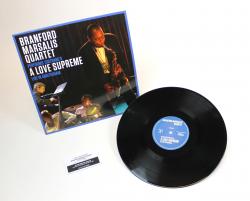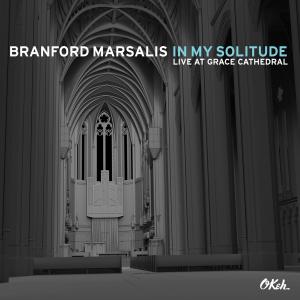 Coltrane’s A Love Supreme: Live in Amsterdam reissue from the Branford Marsalis Quartet out now and available on vinyl for the very first time Read more »
Coltrane’s A Love Supreme: Live in Amsterdam reissue from the Branford Marsalis Quartet out now and available on vinyl for the very first time Read more »
BRANFORD MARSALIS CELEBRATES MELODY AND FEELING ON IN MY SOLITUDE: LIVE AT GRACE CATHEDRAL
 Branford Marsalis continues to prove that there is no context too large or small to contain his gifts. A reigning master of the jazz quartet format, dedicated champion of the duo setting, in-demand soloist of classical ensembles both chamber and orchestral, and session-enhancing special guest on an array of rock, roots and pop performances over the course of his career, his ever-broadening creativity and instrumental command have created the profile of a multi-dimensional musician with few peers among contemporary performers.
Branford Marsalis continues to prove that there is no context too large or small to contain his gifts. A reigning master of the jazz quartet format, dedicated champion of the duo setting, in-demand soloist of classical ensembles both chamber and orchestral, and session-enhancing special guest on an array of rock, roots and pop performances over the course of his career, his ever-broadening creativity and instrumental command have created the profile of a multi-dimensional musician with few peers among contemporary performers.
One setting notably absent from Marsalis’s resume until now has been the unaccompanied solo concert. This most daunting of formats poses particular challenges that were met with his signature blend of serious intent, technical rigor and emotional directness when Marsalis brought his soprano, alto and tenor saxophones to Grace Cathedral on October 5, 2012. This San Francisco landmark, the site of Duke Ellington’s Sacred Concerts in the Sixties and, since 1983, home to recitals at the centerpiece of the annual San Francisco Jazz Festival, proved an ideal setting for a program spanning early and post-bop jazz, baroque and contemporary classical music and spontaneous improvisation. The results can be heard on In My Solitude: Live at Grace Cathedral, the new album that Branford is releasing on his Marsalis Music via OKeh Records imprint on October 21, 2014.
As might be expected from someone with such a refined appreciation of musical excellence, Marsalis prepared by listening to solo recordings by a range of preferred artists, including Sonny Rollins, Steve Lacy and Sam Newsome from the jazz world as well as Anner Blysma, Angela Hewitt and Arno Bornkamp among classical players. He also committed himself to a program that transcended blatant displays of virtuosity. “From my time playing r&b and rock and roll, I can listen like a casual listener,” he notes, “but the challenge for 80% of any audience, for any kind of music, is hearing melody and improvisation based on melody. Playing a lot of notes can be impressive at first, but will quickly make every song sound similar. So everything I played at Grace Cathedral was based on songs with great melodies, not being too `notey,’ and utilizing the feeling in the room.”Getting the most out of the moment may be illustrated most clearly on “Improvisation No. 3,” where Marsalis’s tenor saxophone engages in conversation with a passing siren, while each of the 11 tracks reflects his appreciation of the vast cathedral space. “Every room has a sound of its own,” Branford emphasizes. “There’s a difference between playing in the Village Vanguard, and Alice Tully Hall in Lincoln Center, and Royal Festival Hall in London; and there is definitely a difference playing in Grace Cathedral, with its seven-second delay. Playing solo interludes in other rooms where my quartet performs was not going to prepare me. I had to hear that Grace Cathedral sound in my head.”
The melodies Marsalis chose for inspiration include two of his own, “The Moment I Recall Your Face” and “Blues for One,” Hoagy Carmichael’s uberstandard “Stardust,” Steve Lacy’s “Who Needs It?”, a movement from a baroque sonata by Carl Philipp Emanuel Bach, and “I’m So Glad We Had This Time Together,” the closing theme of Carol Burnett’s classic television show. One of the biggest challenges and clearest signs of Marsalis’s evolving mastery is his interpretation on alto saxophone of “MAI,” a through-composed piece by Japan’s Ryo Noda that tests the mettle of the most accomplished recital-hall saxophonists. “This is a great piece, with multiphonics and other fingerings not typical for the saxophone, that captures the spirit of the shakuhachi, the bamboo flute on which a purely Japanese form of music has been created. While I was in Japan recently, a friend gave me a tour of sorts in which I heard the instrument played in a variety of settings, which helped me to appreciate that patience, rather than getting to the point as quickly as possible, is everything. I wanted to honor the original intent of Noda’s music, and I knew that the audience would relate to the sound of the piece in Grace Cathedral.”
Marsalis also determined to balance the program with four improvisations, each of which sustains the mood of deep feeling and melodic coherence. “Musical spontaneity, like spontaneity in any language, has to be within a context to be meaningful,” he emphasizes, “and the more music you know, the more spontaneous you can be. So I went out on stage with spaces intentionally left in the program, where I could create improvisations clearly based both on what I had just played and the feeling of the room and the audience.”
Regardless of its starting point, each track confirms that, whether playing soprano, alto or tenor saxophone, Marsalis possesses one of the warmest, most direct and expressive sounds of any instrumentalist. “My main concern has been eliminating any shakes in my tone, and classical practice helps a lot with that,” he says, “but otherwise I don’t think about creating something people will think of as my sound. When it’s time to play the gig, I just let it happen.”
“Playing a solo concert is just hard,” Marsalis admits. “After a gig, I’m usually happy to spend time with friends, but after the Grace Cathedral concert I just wanted to go to sleep. After all, if I have an off night with my band, Joey [Calderazzo], Eric [Revis] and Justin [Faulkner] will pick up the slack. But this was just me.”
Yet no reinforcements were required. In My Solitude: Live at Grace Cathedral is both intensely introspective and accessible without compromise, a singular achievement in the singular career of Branford Marsalis.
Categories
Tags in Tags
Branford Marsalis Branford Marsalis Quartet ellis marsalis four mfs playin' tunes Joey Calderazzo Justin Faulkner Marsalis Family marsalis music metamorphosen miguel zenon music redeems new orleansFilter by Artist
Marsalis Music Radio
Join Our Mailing List
- RT @bmarsalis: Compliments of the @T_Blanchard archives. https://t.co/4RsXbyEloa — 3 years 4 weeks ago MarsalisMusic